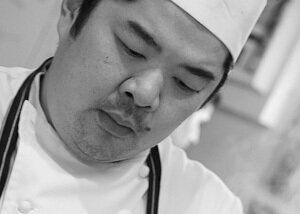
It's a damp, chilly Vancouver Sunday morning in the downtown east side, the Bocuse d'Or Canada Team meet for another in a string practices. Alex Chen greets me with a smile and "I'm stressed, chef." He's not alone, but the truth is I would worry if he told me he wasn't stressed, that's just the way he is. The 36-year-old Chen is, in a word, intense.
We gather in the practice kitchen, a specifically built replica of the competition kitchen in Lyon. It's walls are plastered with photos of Alex's food, quotes by his heroes and a white board covered with scribbled notes and sketches, it documents his life for the past 18 months (reminding me of scenes from Timothy Findlay's Telling of Lies). Alex asks one of his support team for a non-dairy protein shake while he discusses some issues from previous practices that need improvement with his commis, Jack Beers and coach, Dan Olson. They talk frankly and honestly. A decade of working together has cemented a respect and unconditional trust between the two chefs. Beers listens, soaking up the knowledge from the veterans.
Before the practice starts I inspect the team's neatly arranged mis en place, looking for anything that could be rejected by the competition committee, who will strictly monitor what the chefs take into the kitchens.(The competitors can take in peeled, but not cut vegetables; stocks, not finished sauces; cured, but not cooked meats and raw pastry.) My few comments are noted and added to the checklist.
BLOG CONTINUES AFTER SLIDESHOW
Alex sips on his shake..."What the f*#k is this!" he laughs, his comment and cheeky grin relaxes the group and breaks the tension...for a brief moment. Very quickly though, it's back to business as he positions himself ready to compete in front of his cutting board; he tugs tightly on the apron strings around his waist, as if to pull himself into focus, rolls his neck to shake out the kinks and takes a deep breath. Olson gives the OK to start and turns up the music to an uncomfortable level. Chen and Beers begin their five and a half hour marathon.
Like a sprinter launching out of the blocks, as if to cheat time, Chen heats pans on the induction burners while butchering oxtail and peeling the beef tenderloin. His lean, young assistant quietly and methodically goes about his assigned tasks, alternating between chopping ingredients that Chen will cook and intricately constructing the garnishes, at times shooting a glance at his mentor. Olson barks out questions and prompts that keep the chefs focused and most importantly, on time. He refers to the notes taken from previous practices, praising the team for their progress and with his Gretzky-like vision, scans the whole kitchen, anticipating what the cook's will do next.
Finished with the beef, Chen cleans the cutting board and quickly moves on to the other designated protein, the turbot which glistens under the bright kitchen lights. The three fish he will use for the menu are filleted with surgical precision in minutes. Brilliant white fillets lay on the tray well within the budgeted time, and are heavily seasoned by Chen, he glances up, happy to get to practice with the fish. The lobster is next on the list for Chen.
The email notifying the teams of the fish they would be cooking in Lyon dropped at 2:37 a.m. on November 26 giving the teams less than 60 days to practice. French, Label Rouge turbot and European blue lobster. The long awaited notice met with a mixture of relief and apprehension. We were concerned that like the Irish beef, there would be obstacles preventing the import of the product. Fortunately, George Heras at Seven Seas Fish Co. who shares our passion is one of Team Canada's sponsors, generously handled the importing of the turbot and lobster. The competitors are required to prepare three garnishes to accompany the lobster and turbot, one garnish must represent the chef's country and the others will be made from mystery grocery items given to the chefs on the eve of the competition.
On the hobs pots bubble away and aromas fill the small space. Chen dips a spoon into one of the pots, smiles and offers me a taste of his 'Canadian' themed garnish, "How is it, Chef?" The spoonful is a powerhouse of taste, "Oh yeah, that's nice. Tastes like Canada." The secret contents of that spoon will be combined with other components to create what will be a uniquely Canadian garnish. The garnishes for both the beef and the fish entry are the result of hours of discussion and months of development, they have tested over and over again, tweaked and re-tweaked.
During the practice Chen and Beers work in a calm but purposeful manner never pausing, in fact relentlessly pushing. The work is physically and mentally draining. The two craftsmen work as if in a dance, their divergent duties are slowly but inexorably coming together for a grand finale.
As the time winds down, Olson reminds the chefs to stay focused during plate up. He knows this is when fatigue kicks in and mistakes tend to happen, sloppy work at this point can sink a team, they must work cleanly and they must be on time! Beers' hands shake as he transfers piping hot food from trays to the presentation plates, a controlled Chen takes over, gently chiding his young charge for placing a garnish millimetres from where it should be. The serving of the meat platter follows in 30 minutes. Finally it's done. A very solid run. We taste, discuss the highs and lows of the practice and add more notes to the checklist, and then it's time to clean up, plan for the next practice and go into the twilight that has replaced the frosty morning air.
